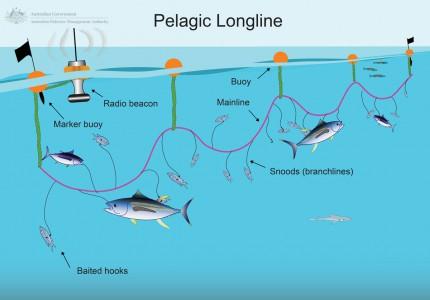Longline gear
Drifting longlines are used in pelagic fisheries targeting tuna and billfish. The longline, or mainline, is suspended horizontally at a pre-determined depth in the water column by buoy lines attached to regularly spaced surface floats. Baited hooks are attached to the mainline by means of thinner branch lines, also called leaders, snoods or gangions. Hooks fish at different depths, depending on their position and the curve of the mainline between floats. A radio beacon is attached to the mainline so that the vessel can keep track of it.
Drifting longlines are set while the vessel is moving ahead. The buoys and branch lines are attached as the mainline feeds out. Mainlines can range from 10 km to 100 km in length, and can carry from 200 to 2000 hooks. The mainline takes 2–6 hours to set, while hauling takes approximately 4–12 hours. [1]
Longlines vary widely in terms of material types, hooks, baits, set configurations and operational practices that influence the diversity, size range and amount of target and non-target catches [2].
Ward and Hindmarsh [3] provide an historical overview of longline fishing gear and practices.
References
- FRDC. http://fish.gov.au/Fishing-Methods/Hook-and-line. Accessed 22 March 2017.
- Clarke SC, Sato M, Small C, et al (2014) Bycatch in longline fisheries for tuna and tuna-like species: A global review of status and mitigation measures. FAO, Rome
-
Ward P, Hindmarsh S (2006) An overview of historical changes in the fishing gear and practices of pelagic longliners. In: Western Central Pacific Fisheries Commission. WCPFC-SC2-2006/FT WP-1, Manila, Philippines, p 31
